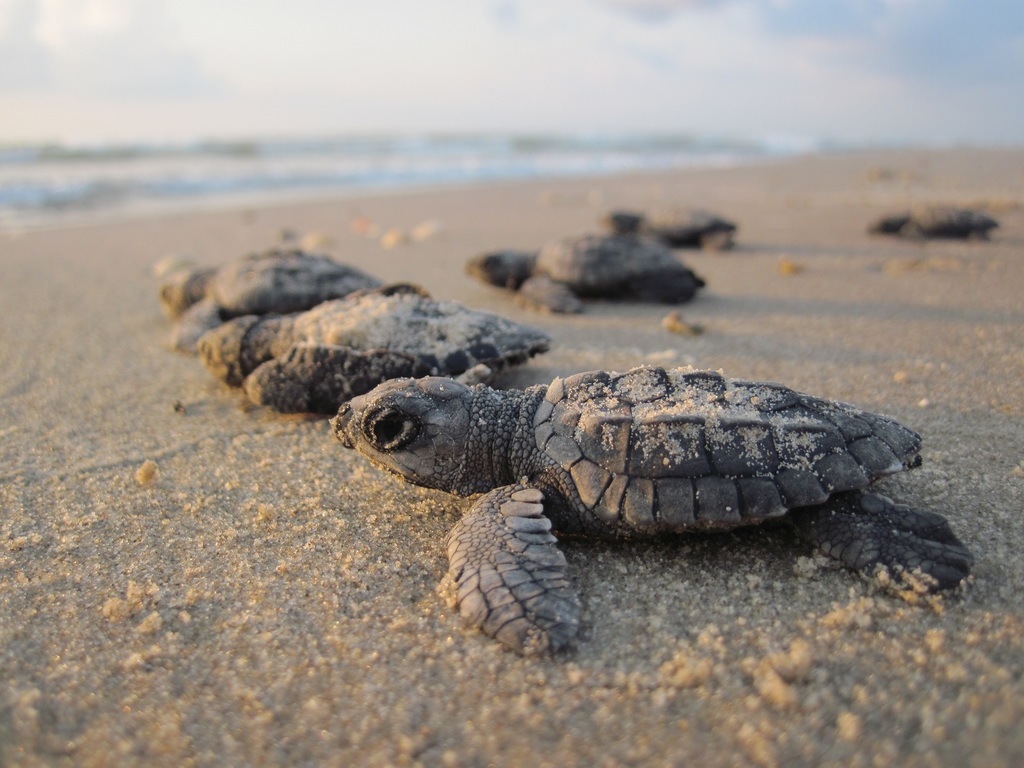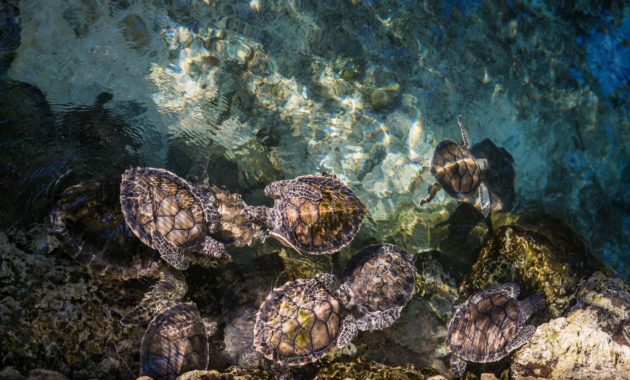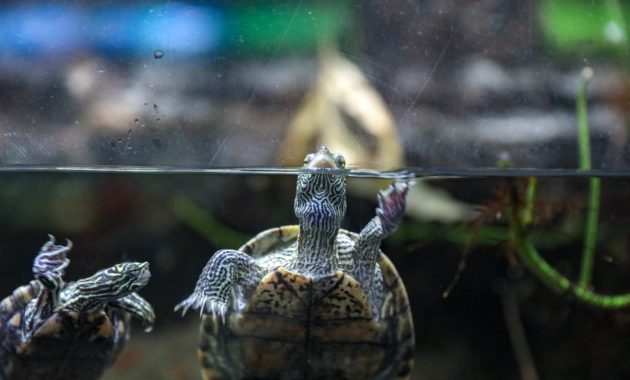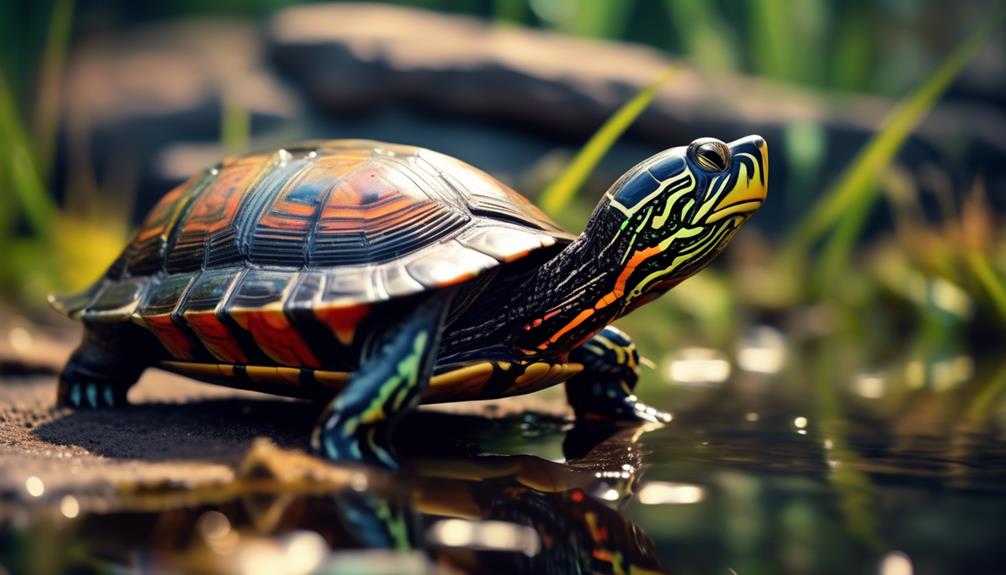
Are you curious about the captivating allure of the Western Painted Turtle? Have you ever wondered about the vibrant colors that adorn its shell and the mysterious nature that surrounds this fascinating creature?
Prepare to be enthralled as we uncover the secrets of this remarkable species, taking you on an immersive journey into their habitat, characteristics, and the enigmatic world they inhabit.
But what makes these turtles so colorful and mysterious? Let’s dive in and find out.
Key Takeaways
- The Western Painted Turtle is a small, semi-aquatic turtle with a lifespan of 25-50 years.
- It is a popular pet turtle breed and can be easily maintained.
- The turtle is native to various states in the US, as well as parts of Mexico and Canada.
- Its distinctive features include an oval, smooth carapace with colors ranging from olive or green to black, with red or yellow borders.
Appearance and Physical Characteristics
The Western Painted Turtle is a small, semi-aquatic reptile with a lifespan of 25-50 years. It’s similar in size and form to Sliders, with an oval, flattened, and smooth carapace. The carapace color ranges from olive or green to black, with red or yellow borders along seams and red crescents or bars on marginal scutes. They’re known for their colorful shell patterns.
These turtles can be housed indoors or in a safe and enclosed garden pond. They require a basking spot with a non-abrasive platform and heat lamp, as well as a UVB lamp and air temperature in the low to mid 80s Fahrenheit. The water should be filtered and pure, with a temperature in the low to mid 70s Fahrenheit. Optional tank substrates, such as river rock, gravel, or sand, should be safe for digestion and not pose a choking hazard.
Native Habitat and Distribution
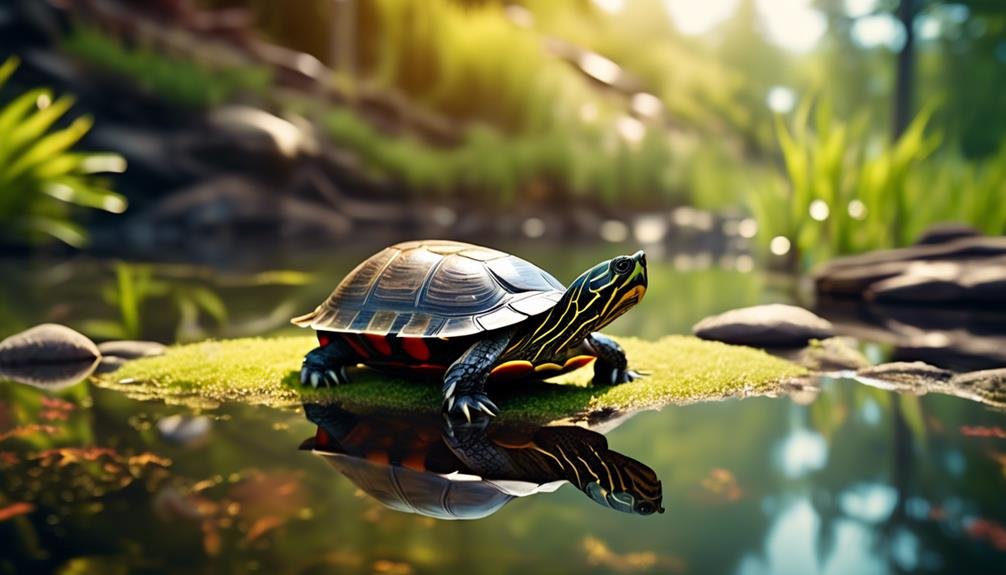
Western Painted Turtles can be found in various states in the US, from east to west, as well as in northern Mexico and southern Canada. Their native habitat and distribution include specific locations such as New Mexico, Oklahoma, Colorado, Idaho, Wyoming, Michigan, North Dakota, South Dakota, Washington, Oregon, Arizona, Indiana, Kansas, Missouri, and Wisconsin. They’re also found in British Columbia, southern Canada, and western Ontario.
These turtles prefer rivers, lakes, streams, and wetlands near bodies of water. Their colorful and mysterious presence adds a touch of beauty to these natural environments. So, if you ever find yourself exploring these areas, keep an eye out for the Western Painted Turtle and its vibrant shell patterns.
Feeding Habits and Diet
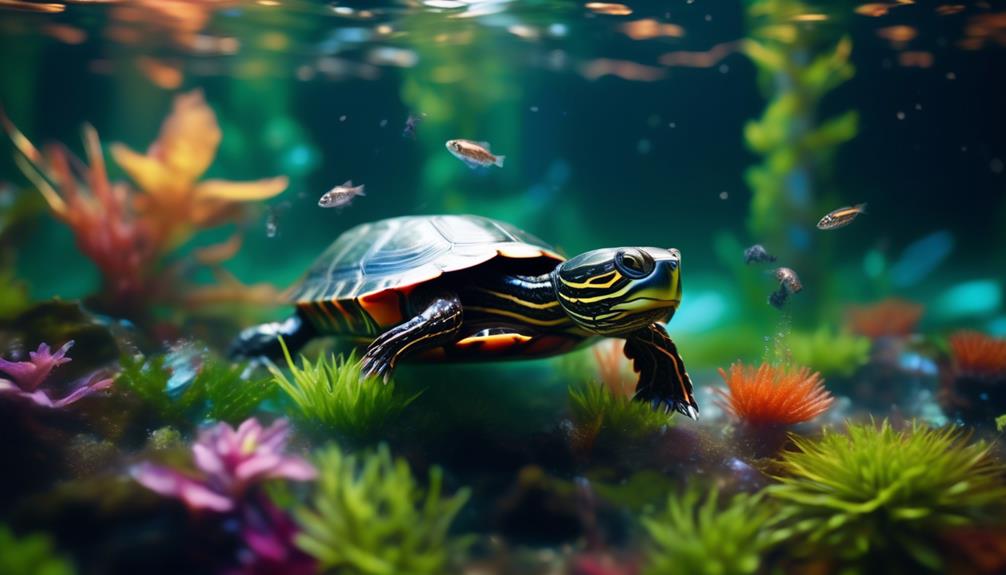
To ensure the health and well-being of the Western Painted Turtle, it’s important to understand its feeding habits and diet. These turtles have an omnivorous diet, meaning they eat a variety of foods. In the wild, they consume a mix of commercial turtle diet, vegetables, fruits, insects, fish, shrimp, aquatic plants, and worms.
When kept as pets, they can be fed a similar diet. It’s crucial to provide a balanced and varied diet to meet their nutritional needs. Offering a combination of commercial turtle food, leafy greens, fruits, and live or frozen protein sources like insects or fish will keep them healthy. Remember to provide fresh water for drinking and swimming, and always monitor their feeding habits to ensure they’re eating properly.
Lifespan and Care Requirements
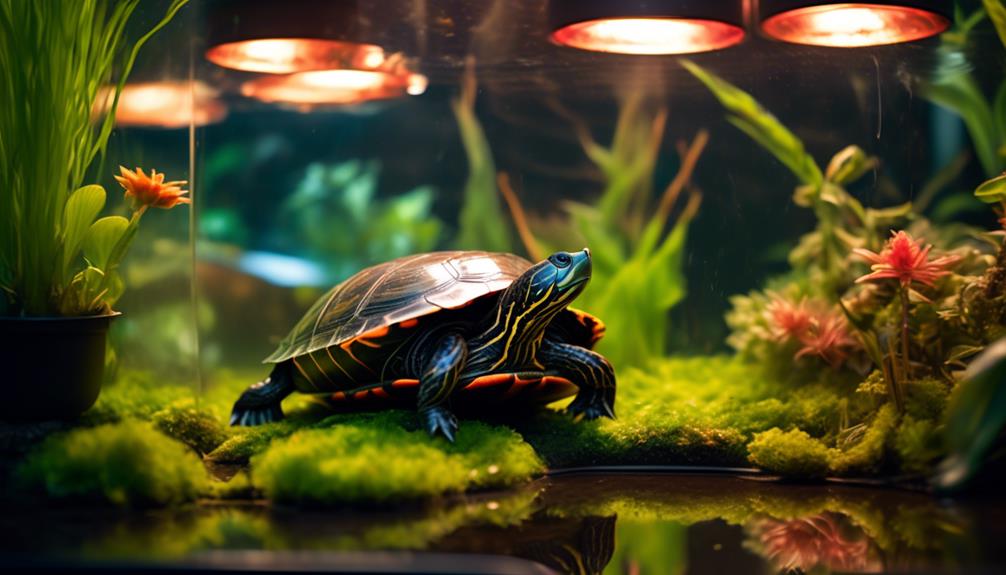
For proper care and longevity of your Western Painted Turtle, it’s important to understand its lifespan and care requirements. Here are some key points to keep in mind:
- Lifespan: Western Painted Turtles can live anywhere from 25 to 50 years if given proper care.
- Housing: They can be kept indoors in a suitable enclosure or in a safe and enclosed garden pond.
- Basking Spot: Provide a non-abrasive platform with a heat lamp for your turtle to bask and regulate its body temperature.
- Temperature: Maintain an air temperature in the enclosure in the low to mid 80s Fahrenheit, and the water temperature in the low to mid 70s Fahrenheit.
- Water Quality: Filtered and pure water is essential for their well-being. Ensure the water is clean and free from contaminants.
Popular as a Pet Turtle
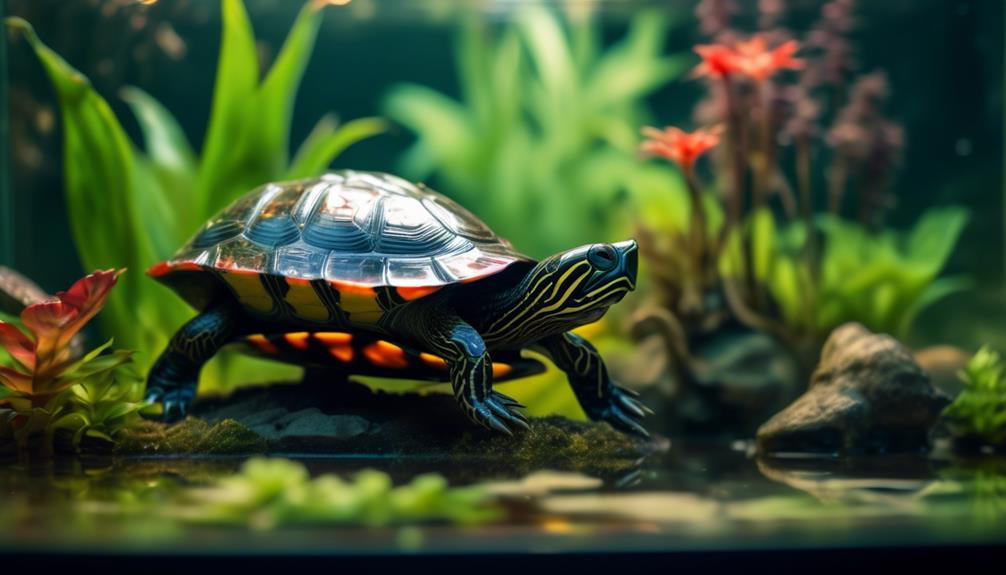
If you’re considering a pet turtle, the Western Painted Turtle is a popular choice due to its vibrant shell patterns and low maintenance requirements. Here is a table that highlights some key features of the Western Painted Turtle as a pet:
| Key Features | Description |
|---|---|
| Size | Small |
| Lifespan | 25-50 years |
| Diet | Commercial turtle diet, vegetables, fruits, insects, fish, shrimp, aquatic plants, and worms |
| Habitat | Can be housed indoors or in a safe and enclosed garden pond |
| Temperature Requirements | Basking spot with non-abrasive platform and heat lamp |
| Water Requirements | Filtered and pure water with temperature in the low to mid 70s Fahrenheit |
With its beautiful colors and easy care, the Western Painted Turtle makes a delightful addition to any turtle lover’s home.
Captive-Bred Western Painted Turtles

Captive-bred Western Painted Turtles are readily available for those interested in owning this popular pet turtle breed. Here are some key points to consider:
- They’re small in size and have a varied length.
- These turtles are semi-aquatic and have a lifespan of 25-50 years.
- Their diet consists of commercial turtle food, vegetables, fruits, insects, fish, shrimp, aquatic plants, and worms.
- They’re low maintenance pets and make great companions.
- Captive-bred turtles are a sustainable option and help protect wild populations.
Environmental Importance and Conservation
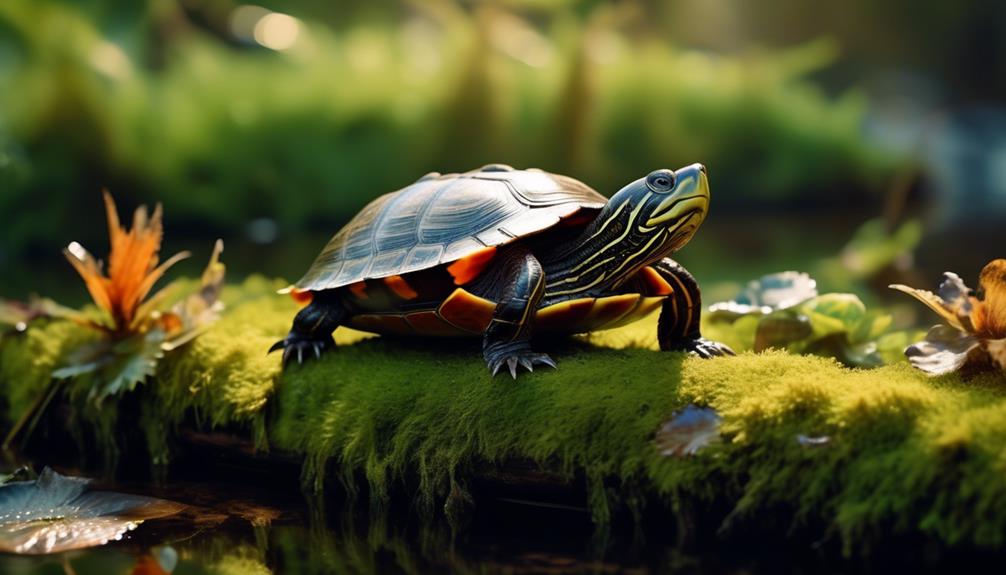
The Western Painted Turtle plays a crucial role in its environment and requires conservation efforts to ensure its survival. This species inhabits freshwater bodies such as ponds and lakes, contributing to the overall biodiversity of these ecosystems. By feeding on a diverse range of plants, insects, and small animals, the Western Painted Turtle helps maintain the balance of its habitat. Unfortunately, populations of this colorful turtle are declining due to habitat loss and pollution. Conservation efforts are necessary to protect their natural habitats and ensure the survival of this species. By raising awareness about the environmental importance of the Western Painted Turtle and implementing conservation measures, we can work towards preserving this unique and valuable reptile for future generations.
| Environmental Importance | Conservation Efforts |
|---|---|
| Maintains ecosystem balance by feeding on plants, insects, and small animals | Protecting natural habitats from destruction and degradation |
| Contributes to the overall biodiversity of freshwater bodies | Raising awareness about the importance of the Western Painted Turtle |
| Plays a role in nutrient cycling and ecosystem functioning | Implementing pollution control measures to reduce water contamination |
| Indicators of environmental health | Supporting captive breeding and reintroduction programs |
Behavior and Activity Patterns
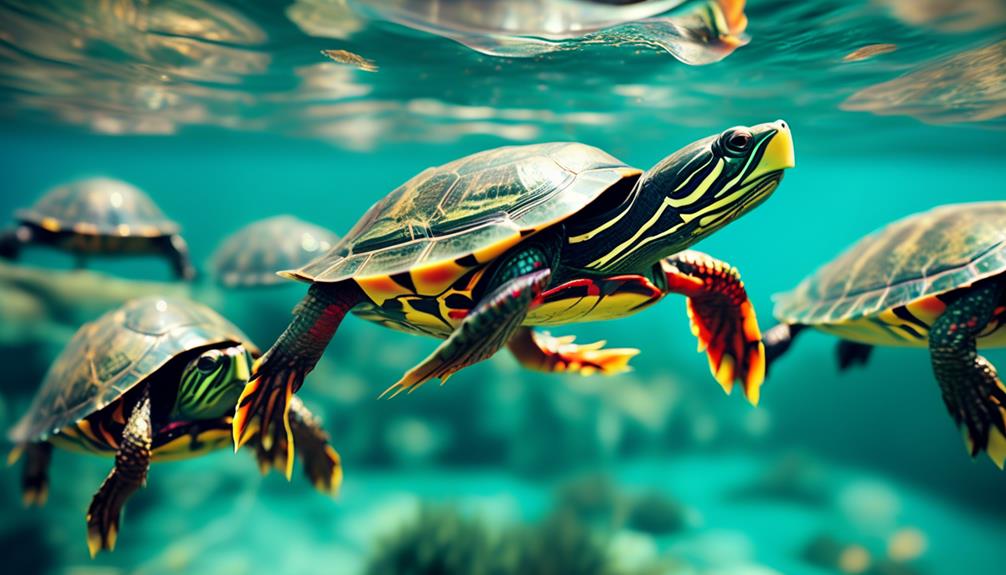
The Western Painted Turtle displays a variety of interesting behavior and follows distinct activity patterns. Here are some fascinating aspects of their behavior:
- Basking: Western Painted Turtles spend a significant amount of time basking in the sun to regulate their body temperature.
- Feeding: These turtles have an omnivorous diet, consisting of plants, insects, and small animals. They’re known to be opportunistic feeders.
- Hibernation: During winter, Western Painted Turtles hibernate either in mud or underwater, where they slow down their metabolism to conserve energy.
- Nesting: Females lay their eggs in nests on land, usually in sandy or gravelly areas near bodies of water. The eggs hatch in the summer.
- Territoriality: Western Painted Turtles can be territorial, especially during the breeding season. They may defend their preferred basking spots or nesting areas.
Reproduction and Nesting Habits
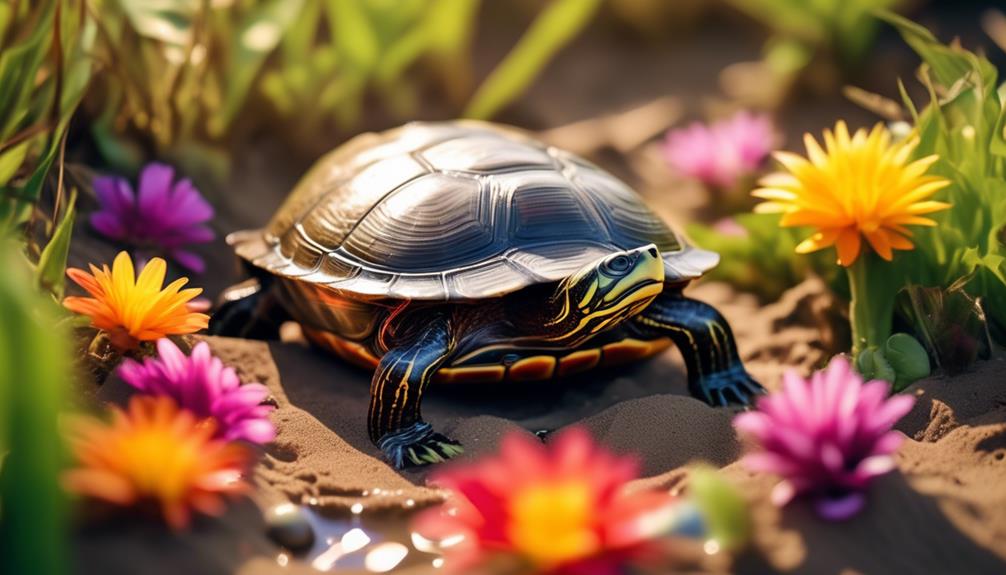
To understand the reproduction and nesting habits of the Western Painted Turtle, it is important to examine their behavior during the breeding season. During this time, males become more aggressive and territorial as they compete for the attention of females. Once a male successfully courts a female, they mate in the water. The female then finds a suitable nesting site on land, usually near bodies of water, and digs a hole to lay her eggs. She carefully buries them and returns to the water, leaving the eggs to incubate for about 70 to 80 days. When the hatchlings emerge, they make their way to the nearest water source. The table below provides a summary of the Western Painted Turtle’s nesting habits:
| Behavior | Description |
|---|---|
| Mating | Males become aggressive and territorial, competing for females. Mating occurs in water. |
| Nesting | Females find a suitable nesting site on land near water and dig a hole to lay eggs. |
| Incubation | Eggs are carefully buried and left to incubate for about 70 to 80 days. |
| Hatching | Hatchlings emerge from the eggs and make their way to the nearest water source. |
Adaptations for Survival
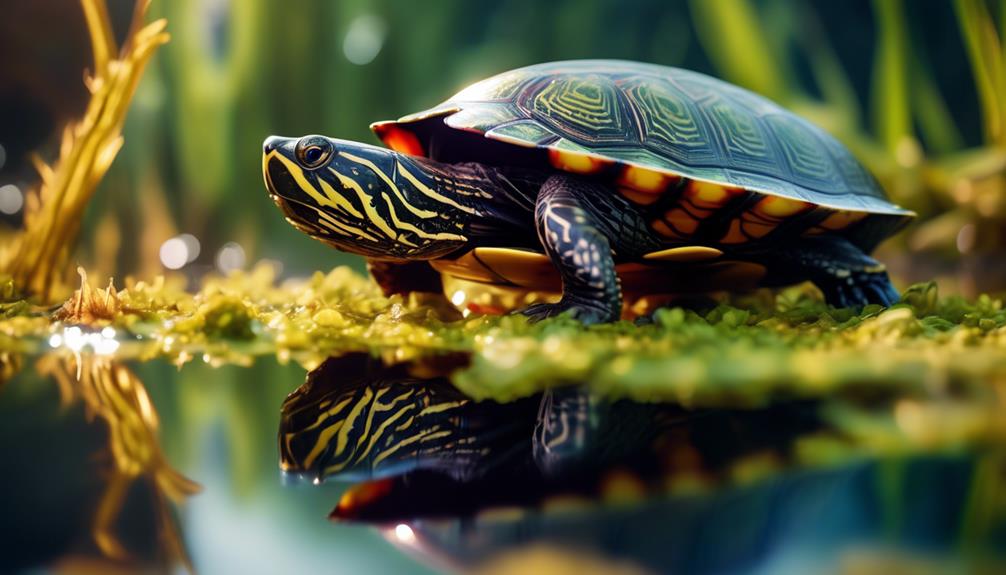
After discussing the nesting habits of the Western Painted Turtle, let’s now explore its remarkable adaptations for survival.
The Western Painted Turtle has developed several unique traits that help it thrive in its environment:
- Camouflage: The colorful shell patterns of the Western Painted Turtle allow it to blend in with its surroundings, making it difficult for predators to spot.
- Shell protection: The turtle’s hard shell provides a strong defense against predators, offering protection from potential threats.
- Aquatic lifestyle: Being a semi-aquatic species, the Western Painted Turtle can swim and dive with ease, allowing it to escape danger in the water.
- Temperature regulation: These turtles are ectothermic, meaning they rely on external sources of heat to regulate their body temperature. They can bask in the sun to warm up or retreat to shaded areas to cool down.
- Hibernation: During the winter months, Western Painted Turtles hibernate in mud or underwater, slowing down their metabolism and conserving energy until spring.
These adaptations have helped the Western Painted Turtle survive and thrive in its diverse habitats.
Threats and Challenges to the Species
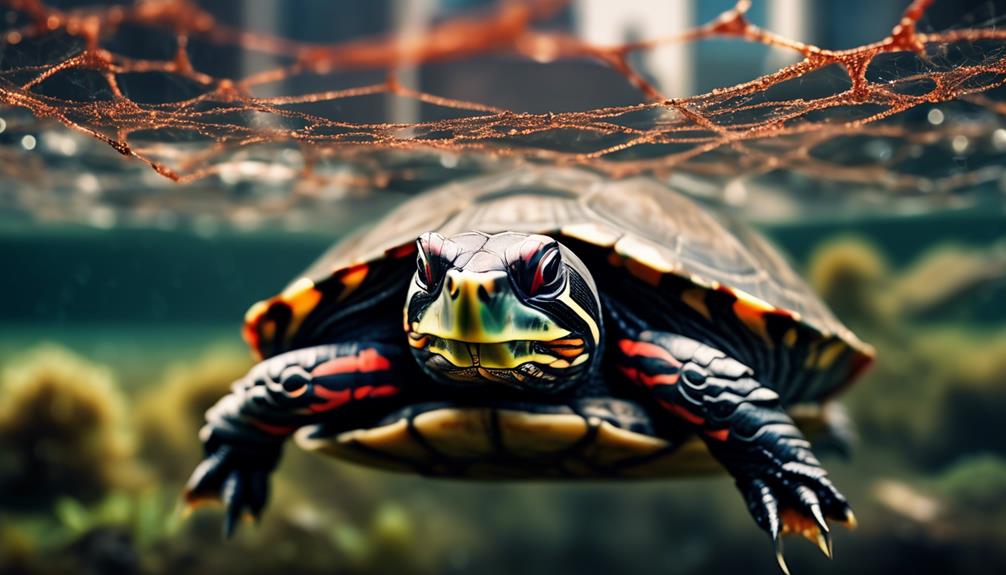
Unfortunately, Western Painted Turtles face numerous threats and challenges in their survival. These threats include habitat loss, pollution, and predation. As human development expands, the turtles lose their natural habitats, such as wetlands and rivers. Pollution, including water pollution from agricultural runoff and litter, also poses a significant threat to their survival. Additionally, the turtles face predation from animals such as raccoons, birds, and larger fish. The table below summarizes the main threats and challenges faced by Western Painted Turtles:
| Threats and Challenges |
|---|
| Habitat loss |
| Pollution |
| Predation |
It is crucial to address these threats and take conservation measures to protect the Western Painted Turtle population and ensure their continued survival in the wild.
Interactions With Humans and the Environment

As we explore the interactions between Western Painted Turtles and humans, it becomes evident that human activities and the environment play a crucial role in shaping the fate of these remarkable reptiles.
- Habitat destruction: Urbanization and the development of infrastructure lead to the destruction of wetlands and nesting sites, which are vital for the survival of Western Painted Turtles.
- Pollution: Pollution from industries and agricultural runoff contaminates the water bodies where the turtles live, affecting their health and reproductive capabilities.
- Climate change: Rising temperatures and changes in precipitation patterns can disrupt the turtles’ nesting and hibernation cycles, impacting their population.
- Illegal pet trade: Western Painted Turtles are often captured from the wild and sold as pets, depleting their numbers in their natural habitats.
- Conservation efforts: Conservation organizations and government agencies are working towards protecting and restoring the habitats of Western Painted Turtles, implementing measures to mitigate threats and educate the public about the importance of preserving these unique creatures.
Tips for Observing Western Painted Turtles in the Wild
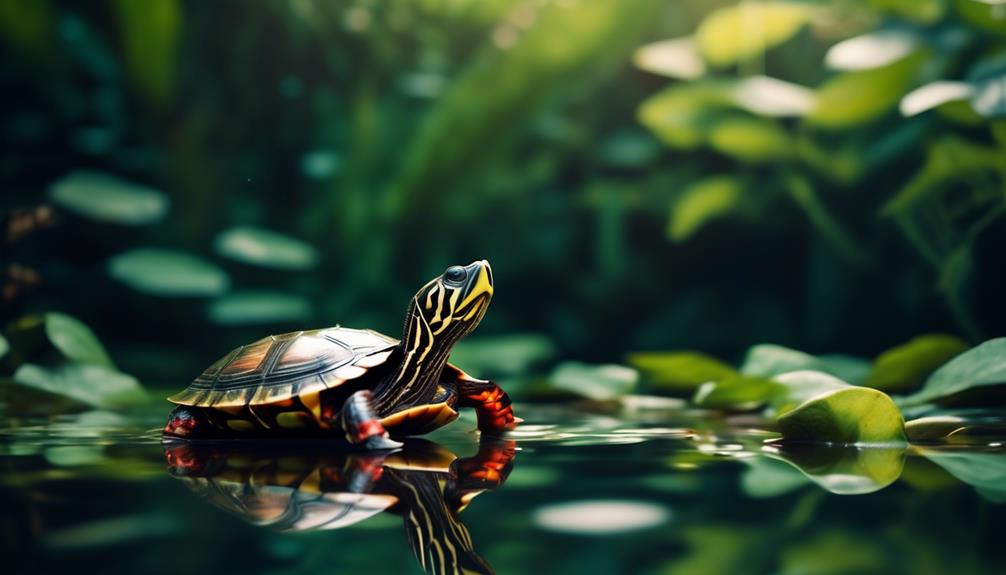
To maximize your chances of observing Western Painted Turtles in their natural habitat, follow these helpful tips.
First, choose the right location. Look for rivers, lakes, streams, and wetlands near bodies of water, as these are the preferred habitats for Western Painted Turtles.
Next, be patient and observant. Turtles are shy and may hide if they sense any disturbance. Find a quiet spot and stay still, allowing the turtles to feel comfortable and come out of their hiding places.
Additionally, try to visit during the warmest parts of the day when the turtles are more likely to be basking in the sun.
Finally, bring binoculars or a camera with a zoom lens to get a closer look without disturbing the turtles.
Happy observing!
Frequently Asked Questions
How Do Western Painted Turtles Protect Themselves From Predators?
Western painted turtles protect themselves from predators through a combination of strategies. They rely on their shell for physical defense, camouflage in their surroundings, and quick movements to escape danger.
What Are Some Interesting Adaptations That Western Painted Turtles Have Developed for Survival?
Some interesting adaptations that Western Painted Turtles have developed for survival include a colorful shell pattern, the ability to regulate body temperature by basking in the sun, and the ability to hibernate during winter.
Are There Any Specific Conservation Efforts in Place to Protect Western Painted Turtle Populations?
There are specific conservation efforts in place to protect Western Painted Turtle populations. These efforts aim to address habitat loss and pollution, which are contributing factors to the declining populations of these colorful and mysterious turtles.
How Do Western Painted Turtles Communicate With Each Other?
Western painted turtles communicate with each other through a variety of methods, such as visual displays, tactile interactions, and vocalizations. They use body movements, head bobbing, and hissing sounds to convey messages and establish social hierarchies among themselves.
Can Western Painted Turtles Be Kept as Pets in Smaller Enclosures, Such as Tanks or Terrariums?
Yes, Western Painted Turtles can be kept as pets in smaller enclosures like tanks or terrariums. However, it’s important to provide them with a basking spot, UVB lamp, clean water, and a proper diet to ensure their well-being.
What Makes Western Painted Turtles Colorful and Mysterious Like Eastern Box Turtles?
Western painted turtles are as colorful and mysterious as their Eastern box turtle counterparts. Their vibrant shells range from green to red, and their patterns are truly mesmerizing. These colorful Eastern box turtles are a sight to behold, adding a sense of wonder to their natural habitats.
Conclusion
So, if you’re looking to explore the vibrant and enigmatic world of the Western Painted Turtle, you’re in for a treat!
From their stunning colors to their unique adaptations for survival, these captivating creatures have so much to offer.
Whether you’re observing them in the wild or considering them as a pet, the Western Painted Turtle will continue to fascinate and inspire with their beauty and mystery.
Don’t miss out on the opportunity to delve into their captivating world!

